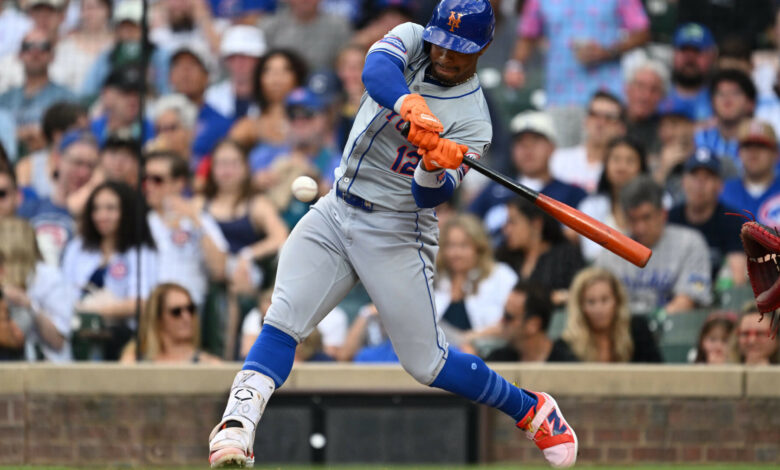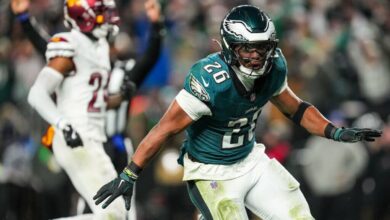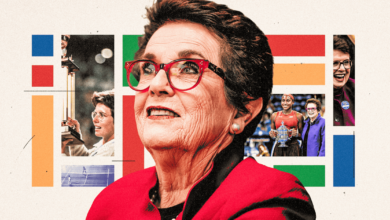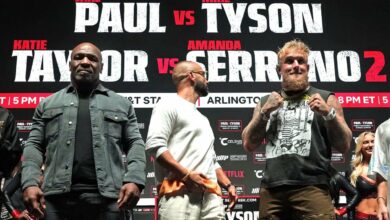Why One of Baseball’s Unique Skills, Switch Hitting, Is Becoming Extinct

CLEVELAND — Francisco Lindor is a natural right-handed hitter who desperately wanted to switch hit as a kid to be more like his heroes. His brother and cousin were both switch hitters, as was his favorite player, Hall of Fame second baseman Roberto Alomar.
Lindor begged his father, Miguel, to bat left-handed. Miguel fought it for years because Lindor was such a good right-hander. Why would you deliberately make yourself worse by doing something so unnatural? It didn’t make sense.
“That was my dad’s way of pushing me to practice,” Lindor said. “If I did everything right, I could hit from the left side.”

Free daily sports updates straight to your inbox.
Free daily sports updates straight to your inbox.
Now, Lindor is part of a dwindling subset of players. Switch hitters are a dying breed in the major leagues, especially among Americans.
Of the roughly 550 batters who have recorded a plate appearance through the end of June, only 58 were switch hitters, according to Stathead. It continues a trend from last season, when switch hitters in baseball fell to their lowest numbers in 50 years.
Only 26 of them are American-born players, one more than last year, when the lowest number of Americans was recorded in nearly 60 years.
While Latin American players are often encouraged to switch as children, it has become almost taboo among young people in America. Seattle Mariners manager Scott Servais was a right-handed catcher in the majors for 11 years. He believes being a switch hitter is the biggest advantage in all of sports.
“Youth baseball in our country has changed drastically in the last 15 years,” Servais said. “Ultimately, the focus comes down to college scholarships or professional baseball, and the lack of patience to develop those things in young players. So they go on select teams and travel all over the country and mom and dad pay a lot of money to put you in front of all the top coaches. Why would we ever put you in a situation where you could fail? And you’re going to fail. Switch hitting is really hard. It’s really hard when you’re young. And they’re afraid to fail.”

Mets shortstop Francisco Lindor, who had to convince his father to let him switch batters, is among a shrinking group of players in the major leagues who can hit on both sides of the ball. (Charles LeClaire/USA Today)
Mariners catcher Cal Raleigh isn’t sure which side of the plate is his natural side. Raleigh, like Baltimore’s Adley Rutschman, is a triple-world-scoring combination of switch-hitting catcher with power. He’s always been right-handed dominant in everyday activities, but from his earliest baseball memories, the slugging catcher could swing the bat from either side of the plate because his father made him do it.
“Every day I thank the Lord that my dad made me a switch hitter,” Raleigh said. “‘Cause I see some of that nasty stuff that gets thrown out there.”
The number of switch hitters in baseball has been declining for the past decade, finally hitting its low point last year, when just 63 of the more than 650 players were hitting on both sides of the plate. That’s down from the record of 111 switch hitters set in 1998. According to Stathead, American-born switch hitters peaked at 78 in 1987.
Carlos Beltrán was a rookie with the Kansas City Royals during baseball’s switch-hitting peak. He played for 20 years and hit 438 home runs as one of the best switch hitters of his era. He began toying with the idea after playing winter ball in Puerto Rico with Bernie Williams, who also switch-hit. Beltrán had such a hard time staying on offspeed pitches and breaking balls that he wanted to give up and go back to hitting right-handed only. Kevin Long, now the Phillies’ hitting coach, was with Beltrán in the minor leagues and encouraged him to continue.
“Thank God for Kevin Long,” Beltrán said. “He said, ‘We’re so close. Let’s keep going. Keep trying.’ I was thankful that I had a coach who believed that what I was doing was the right thing. And he didn’t really let me go back to the right side. I don’t know what my career would have been like if I had just been right-handed.”

Carlos Beltran credits Kevin Long for encouraging him to persevere in the minor leagues when he struggled with hitting left-handed. (Bob Levey/Getty Images)
Baseball has changed dramatically since Beltrán played. The game has become more specialized, even at the youth level, as batters chase data and advanced statistics. The changes have angered some of the greats of the past.
“This generation has lost the ability to score,” said former Reds star Eric Davis, now a special assistant and traveling instructor for the club. “You have a lot of guys today who are stuck in exit velocity and launch angle and they don’t learn how to hit. They’re not good hitters. So the game won’t bless them unless you develop the ability to play the game long. And switch hitting is a way for some guys to play the game long.”
Davis, who batted right-handed during his 17 seasons in the majors, switched early in his career but said he quit as a minor leaguer because his coaches told him he had no trouble hitting sliders. The majority of switch hitters are born right-handers who learn to hit left-handed. The biggest advantage is being able to hit sliders from right-handed pitchers that break toward the left-handed batter, rather than trying to hit pitches that run away from the right-handed pitcher.
In youth leagues, however, pitchers don’t throw breaking pitches until they’re teenagers, and most don’t develop great movement until closer to high school. It leaves kids struggling to hit from a side of the plate where they’re not comfortable and successful. And they do it to hit breaking pitches that don’t break dramatically until years later.
There’s no magic age to start switching, but several hitters and coaches who have been interviewed on the subject believe the right age to start ranges from 9 or 10 to about 13. Beltran, who started switching in the minor leagues, is a rare exception. For teens who wait until high school, it’s often too late.
“If you’re having trouble with sliders and you want the ball to come to you instead of away from you, work on being a switch hitter,” said Cleveland Guardians veteran coach Sandy Alomar Jr., who spent 20 years in the majors as a catcher. Alomar came up as a switch hitter, as did his brother Roberto. His father had both boys switch hitters at a young age. Sandy batted left-handed in his first year in the minors, while Roberto amassed 2,724 hits, 210 home runs and 12 consecutive All-Star appearances as one of the greatest switch hitters of all time. He was inducted into the Baseball Hall of Fame in 2011.
Rutschman, Lindor and Cleveland’s José Ramírez are among the best switch hitters in the game today. Ramírez made his sixth All-Star team this year, and Rutschman his second. Lindor didn’t make the team, but his season was good enough to warrant another All-Star bid.

José Ramírez, third baseman for the Guardians and a player who participated in this year’s Home Run Derby, is one of baseball’s best switch hitters. (Jerome Miron / USA Today)
Reds third baseman Jeimer Candelario is one of the few American-born switch hitters, but he actually skews the numbers a bit. Candelario counts as a U.S. player because he was born in New York City, but his father moved the family to the Dominican Republic when he was 5 to open a baseball academy. Candelario worked off a plan his father developed to hit from both sides of the plate every day as a kid.
Latino players made up about 30 percent of major league rosters last year. They made up more than 60 percent of all switch hitters.
“It’s a lot of work. It’s not easy,” Candelario said. “Not every day is going to be perfect, but it’s consistent work every day. If you don’t fall in love with it, you’re not going to be successful. You have to love it.”
Not everyone is buying the concept. Mets hitting coach Eric Chavez, who hit .268 with 260 home runs in 17 years as a left-handed third baseman, is amazed at what Lindor can do, but he doesn’t encourage others to try it.
“You’re two different people, two different swings,” he said. “Because the body moves differently. You’re right-handed dominant, now you come to the left side and your right hand is on the bottom (of the club). You’re training two different swings.
“You can be right-handed and feel great. In that same game, you can be left-handed and think, ‘Oh shit, where’s my swing?'”
Alex Miklos played Division I baseball at Kent State University, where he was a three-year captain and led the nation in triples in 2014. He is now part owner of BioSport Athletics, a baseball and softball facility in suburban Cleveland that opened two years ago and has trained between 900 and 1,000 athletes from ages 7 through the professional ranks. Miklos estimates that about half of the players who have trained at BioSport are position players. Of those 450 to 500, he said, about 10 have asked about switch hitting and only three or four have worked on it consistently.
“There’s no such thing as too early. The sooner the better,” Miklos said. “But there’s definitely too late. It’s something you have to commit to. By the time you’re 13 or 14, you’ve established patterns. It’s really hard to develop that ability from the other side of the plate.”
Youth sports have become so competitive in the U.S. that kids feel like every at-bat matters, even at the club level or in travel leagues, Miklos said. It can be hard for kids — and coaches — to “give away” at-bats in games to work on player development, such as a right-handed batter learning to hit left-handed.
Whether the number of major-league switch hitters will increase again, especially in the United States, depends on how youth leagues handle it in the future. The data is not encouraging.
Of the approximately 140 top baseball prospects listed on FanGraphs’ preseason list, ranging from Class AAA to Rookie ball, 34 were switch hitters who had yet to make their debut.
Eight of them were Americans.

GO DEEPER
Missing Bats, Part 1: How an Obsession with Strikeouts Upended Baseball’s Balance
(Photo by Francisco Lindor: Jamie Sabau/Getty Images)




